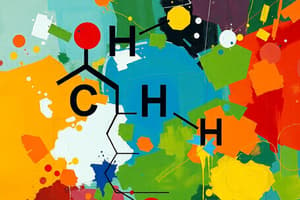Podcast
Questions and Answers
What is the IUPAC name for an aldehyde with the longest carbon chain containing five carbon atoms?
What is the IUPAC name for an aldehyde with the longest carbon chain containing five carbon atoms?
pentanal
How are aldehydes with one to four carbon atoms often referred to in terms of their common names?
How are aldehydes with one to four carbon atoms often referred to in terms of their common names?
by their common names, which end in aldehyde
What happens to aldehydes when they are oxidized?
What happens to aldehydes when they are oxidized?
they oxidize readily to form carboxylic acids
How are aldehydes reduced?
How are aldehydes reduced?
Flashcards are hidden until you start studying
Study Notes
Carbonyl Group
- The carbonyl group consists of a carbon atom bonded to three other atoms by sigma bonds, forming a plane with 120° angles.
- The remaining p orbital of the carbon overlaps a p orbital of oxygen to form a pi bond, resulting in a double bond between carbon and oxygen.
- The electrons of the carbonyl double bond are not equally shared, with the mobile pi cloud pulled strongly toward the more electronegative oxygen atom.
Structure of Aldehydes
- In an aldehyde, the carbon of the carbonyl group is bonded to at least one hydrogen atom.
- The carbon may also be bonded to another hydrogen atom, a carbon of an alkyl group (aliphatic compound), or an aromatic ring.
- The carbonyl group can be drawn as separate atoms or written as (-CHO) in condensed structural formulas.
Nomenclature of Aldehydes
- Aldehydes are named by replacing the (e) of the corresponding alkane name with (-al) in the IUPAC system.
- The suffix "-al" indicates the presence of an aldehyde group.
- The parent chain is selected by identifying the longest chain that includes the carbon atom of the aldehydic group.
- The aldehydic carbon is assigned number 1 when numbering the parent chain.
Physical Properties of Aldehydes
- At room temperature, methanal (formaldehyde) and ethanal (acetaldehyde) are gases.
- Aldehydes with 3 to 10 carbon atoms are liquids.
- The polar carbonyl group influences the boiling points and solubility of aldehydes in water.
- The boiling points of aldehydes increase as the number of carbon atoms in the chain increases.
- Aldehydes with 1 to 4 carbon atoms are very soluble in water, while those with 5 or more carbon atoms are not very soluble.
Reactions of Aldehydes
- Aldehydes produced by the oxidation of primary alcohols oxidize readily to carboxylic acids.
- Aldehydes are reduced by hydrogen to form primary alcohols, requiring a catalyst such as nickel, platinum, or palladium.
Studying That Suits You
Use AI to generate personalized quizzes and flashcards to suit your learning preferences.




